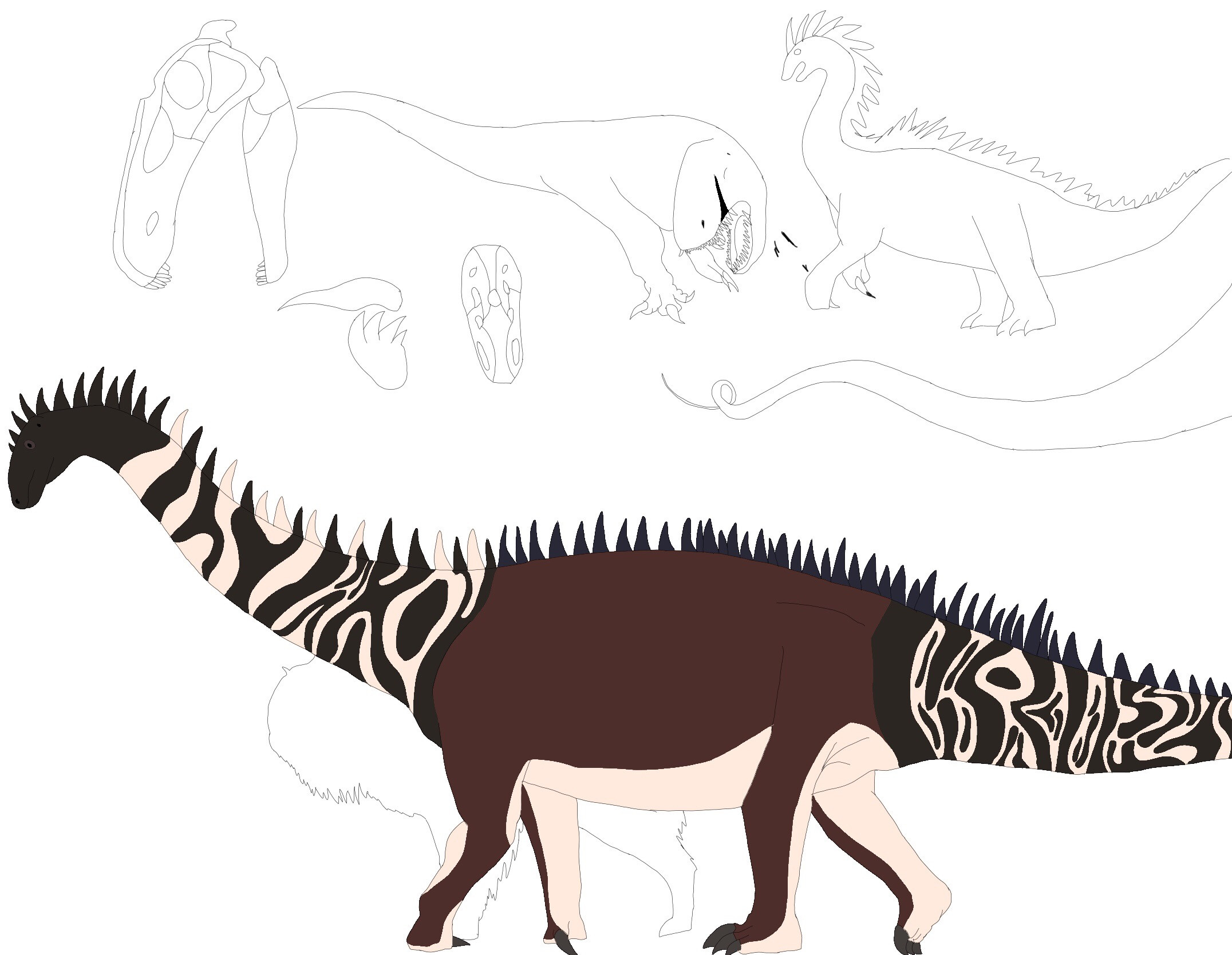HOME | DD
 Dinomaster337 — Paleogaps #4- Rhonesaurus vitalispinus
Dinomaster337 — Paleogaps #4- Rhonesaurus vitalispinus

#dinosaur #palaeoart #paleontology #sauropod #paleogaps
Published: 2020-02-01 16:10:31 +0000 UTC; Views: 1768; Favourites: 30; Downloads: 0
Redirect to original
Description
Rhonesaurus vitalispinusScientific name: “Lively spine lizard of the Rhône”
Height: 10 feet at the shoulders
Length: 38-49 feet
Weight: 15 tons
Habitat: Forests
Region: Southern France (Vaste Forêt formation)
Time period: late Jurassic (155-152 mya)
The discovery of Kentropelta, in 2035, and Theotitan, in 2040, was proof of a different ecosystem in Southern France compared to much of Europe: even during the Late Jurassic, it was much more lush and tropical, largely due to its proximity to the ocean. This made the newly named Vaste Forêt Formation wet largely year round, as opposed to the inland habitats, which were only seasonally wet, and based on the types of stone in the formation, as well as plant fossils, shows that the area was mostly forested rather than the mosaic typical of contemporary formations, such as the Morrison or Lourinhã.
However, a specimen discovered in 2042 was a true display of some of the examples of the odd directions evolution was taking in the Vaste Forêt. A group of hikers had been walking along side the banks of the Rhône River, whose mouth lies near Marsille where Kentropelta was discovered, and the found a strange skull in the mud. When they investigated closer, it bore similarities to a dinosaur skull of some description and they reported the find to the local news, which brought in a group of paleontologists to dig up the specimen. They found that is was a diplodocid sauropod (containing 2/3 of the skull, a fragmentary hip, a femur, and half the vertebrae in its tail) about the height of a elephant at the shoulders, which they initially concluded made it a juvenile.
However, study of the growth rings preserved in the femur found this to not be the case. In fact, based on their findings, the team found the specimen was actually very old when it died. This is further supported by pathologies found in the tail vertebrae, which appear show signs of a degenerative condition similar to arthritis. This made the specimen one of the earliest examples of dwarfism in sauropods, along with the contemporary Europasaurus, and the first publicized example in diplodocids, alongside a specimen found in the same region as Europasaurus that has yet to be described.
The team named the sauropod Rhonesaurus, after the river it was found near. The specific name refers to the elderly age of the specimen.
Somewhat of an odd puzzle is that, while Rhonesaurus displays dwarfism, the contemporary brachiosaur Theotitan rivals some of the largest titanosaurs, despite both living in the same region. Current thinking is that the different solutions occurred due to differing bauplans: Theoritan’s brachiosaur body plan is taller than it is long and thus more compact than a diplodicid, allowing it to take greater advantage of the dense forests. Rhonesaurus, being smaller, has greater access to this habitat than its giant relative, such as Supersaurus.
There’s little doubt that Rhonesaurus was a browser, feeding on the smaller trees and larger ferns of the forests. However, this puts it at odd with Kentropelta, which was of a similar size and seemingly occupied a similar niche. As for how the two managed to coexist, the answer most likely lies in their skulls: the team describing Rhonesaurus noted that it’s mouth was significantly wider than Kentropelta’s, implying a much more varied diet. The researchers proposed that Kentropelta may have been strictly a middle browser, while Rhonesaurus was a mid/low browser hybrid, based not only on Rhonesaurus’s wider mouth, but also its longer, more flexible neck, which gives it a larger feeding range.
Naturally, its smaller size meant that it was less defended against large predators than the massive sauropods. However, evidence had previously surfaced that hints it might have been able to adapt to this pressure: in 2043, a off France’s Mediterranean coast, a new Rhonesaurus specimen was found, which preserved a partial manus with the claw on its first digit. This claw was about as long as the manus itself and appears to have possessed some blade-like properties, indicating a possible use for defense or even infraspecific combat. A couple months later, a megalosaur skull was found, with a deep incision down its snout, which matched the shape of the claw on the newly described specimen
*silhouette is of an American Bison (may be off, not sure)
*colors are speculative
-Notable specimens: (2042) type specimen, named “Old Man Edgard,” consisting of 2/3 of the skull, a fragmentary hip, a femur, and arthritic vertebrae in its tail.
-2043 specimen with fragmentary skull, ribs, neck vertebrae, and a well kept manus, named “Henri.”
———————————
Theotitan belongs to AlphaX9

























